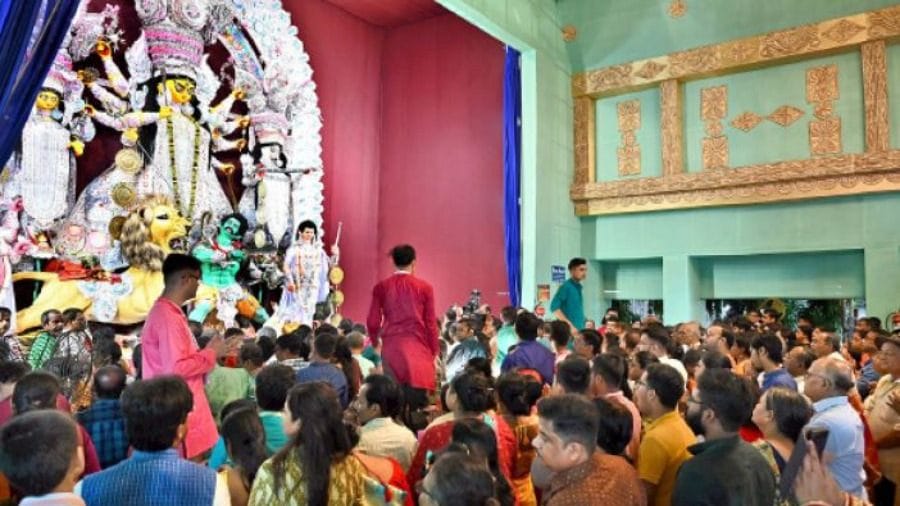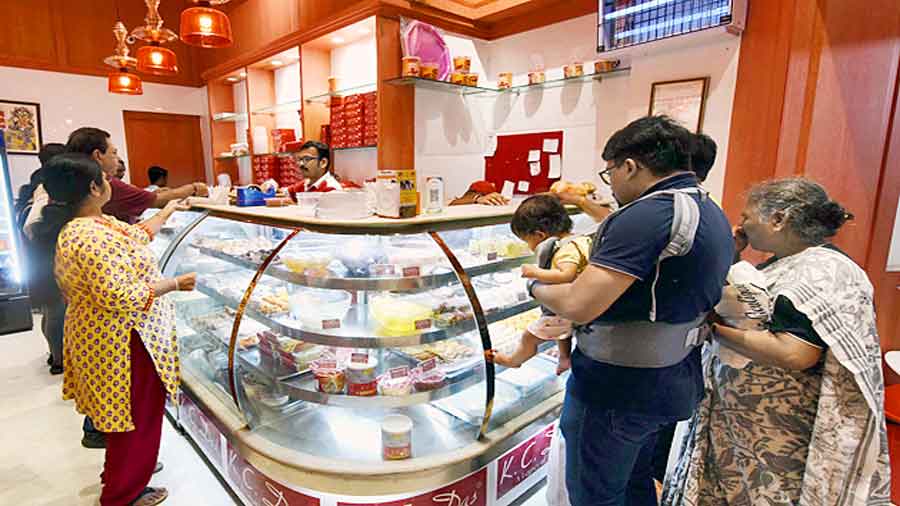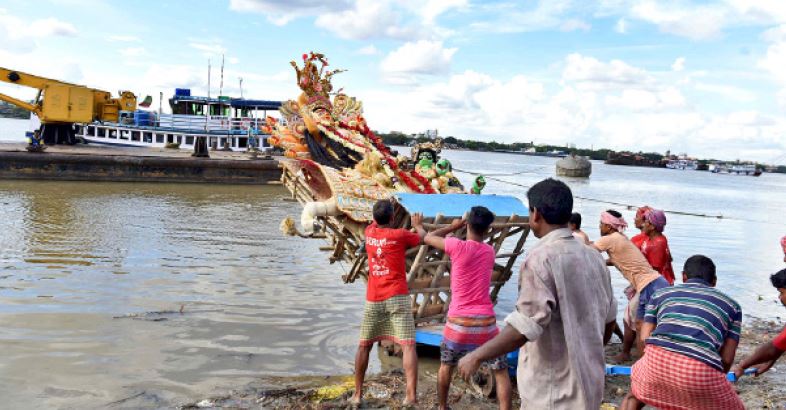An early start to pandal-hopping, unruly bikers and occasional showers marked the city’s biggest festival, now included on the Unesco’slist of “intangible cultural heritage”.
The Telegraph presents the Durga Puja celebration report card
Pandal-hopping
Mahalaya was on September 25. Devipaksha started the day after. But for Kolkatans, Durga Puja started even before that.
On September 22, chief minister Mamata Banerjee inaugurated three pujas — Sreebhumi Sporting Club, FD Block Sarbojanin in Salt Lake and Tala Prattay.
The Unesco New Delhi cluster director and representative,Eric Falt, was in town to inaugurate a preview show, Durga Puja Art, in which 24 community pujas and two family pujas took part.
Police fought hard to keep the streets clear for VIP movement as curious onlookers thronged pandals. Several big-ticket pujas witnessed heavy footfall from Tritiya (September 28). Chetla Agrani and Suruchi Sangha recorded tens of thousands of visitors from Chaturthi (September 29).
Weather
Rain had threatened to play the asura this Puja as a cyclonic circulation loomed over the Bay of Bengal. But on most days, the weather provided the perfect backdrop for Puja revelry. The system on the Bay moved towards Andhra Pradesh coast, sparing Kolkata.
The city got around 65mm of rain between Panchami (September 30) and Dashami (October 5). The showers were occasional and lacked punch to dent the spirit of pandal-hoppers.
Metro Railway
Weathering snags in the run-up to Puja, Kolkata’s transport lifeline delivered when it mattered. More than 37.4 lakh people travelled by Metro in the north-south corridor from Panchami to Dashami, as the carrier resumed nightlong Puja service after two Covid-ridden years.The trains were crowded but no major snag was reported.
Heavy deployment of police and RPF at stations like Kalighat and Dum Dum helped in crowd control. The 2022 passenger count was lesser than that in 2019, when Metro Railway had ferried around 46 lakh passengers between Panchami and Dashami. East-West Metro, which now operates between Sealdah and Sector V, ferried around 1,80,000 passengers between Panchami and Dashami.
App cabs
A Jadavpur resident had his Uber ride cancelled three times on Navami evening. He started trying to book a ride to New Alipore around 7.15pm and finally boarded a car around 8pm.
A woman travelled by Uber between her Dum Dum home and friends’ houses in south Kolkata. She made at least six trips between Saptami and Dashami. She faced two cancellations on an average for each ride. Frequent cancellations from drivers of app cabs was a menace during the Puja days. Many Kolkatans said they were okay with a surge in fare but not with random cancellations.
“On Ashtami night, I had to face three Uber cancellations before finding a ride from Park Street to Bondel Road,” said a Ballygunge resident. “One of the drivers asked where I would be going and if I would be paying in cash. When I said I would pay online, he cancelled the trip,” said the 39-year-old man.
Many Kolkatans said drivers would often “grill” them before picking them up. “It was so irritating. The whole idea of a hassle-free ride goes for a toss,” said a woman in Behala, southwest Kolkata.
Wayward bikers
More than 7,000 two-wheeler riders have been prosecuted for riding without helmets between Sashthi (Saturday) and Dashami in Kolkata, the police said.
An officer said more vehicles were on the roads this year compared with the last two years, resulting in a steep jump in the number of violations.
“Motorcyclists without helmets turned out to be a big problem during the Puja. We prosecuted 7,302 two-wheeler riders. The majority of them were out for pandal-hopping and were reluctant to put on their helmets,” an officer of the traffic department said. The police said most of the violations were reported on Ashtami. An officer in south Kolkata said a large number of the women pillion riders were unwilling to don the headgear.
Traffic
Traffic was smooth on the Puja days except for a few stretches that witnessed congestion during the rush hours of pandal-hopping, police said.
The Telegraph found traffic was heavy on stretches like the Rashbehari connector, Tollygunge Circular Road, pockets of EM Bypass and north Kolkata. The intersection of Rashbehari Avenue with SP Mukherjee Road and Sarat Bose Road were particularly bad.
“We tried our best to keep traffic moving despite a surge in the number of vehicles and we succeeded in the majority of the arterial roads,” said an officer posted near Kalighat.
A resident of Gariahat, who was out pandal-hopping on Saptami, said his car was caught in a snarl that took almost double the time to clear compared with the time it takes to travel from Gariahat to the Rashbehari crossing. “I had to scuttle my pandal-hopping plan because of the traffic jam. Traffic was better once I crossed Hazra,” said Aniruddha Bhattacharya.
A senior officer said there was no disruption because of the Sreebhumi puja on VIP Road. In previous years, traffic snarls in front of the big-ticket puja would affect traffic on EM Bypass.
Parking
For many revellers, finding a legitimate parking spot was one of the biggest challenges.
Between Sashthi and Dashami, 11,498 people were prosecuted for illegal parking. The roads leading to big-ticket pujas were heavily barricaded and finding the right spot to park the car was a nightmare. Senior citizens found it exceptionally hard to walk long stretches between the parking spots and the pandals. As a result, many people were forced to park their cars wherever they could. In traffic parlance, wherever usually means “no-parking zones”.
Around 10.30pm on Saptami, a bunch of civic volunteers and a traffic constable were busy clamping the wheels of a series of cars parked on a stretch of Southern Avenue near the Mudiali Club and Shibmandir pandals. The same night, a Chetla resident had gone to Mudiali and Shibmandir with his wife, daughter and aunt, a senior citizen. He could find a parking slot after almost 30 minutes. While returning after an hour, he saw a cop approaching the car with a clamp. He was let off after repeated requests.
Waste disposal
As Kolkata celebrated, an army of people worked tirelessly to keep the streets clean. About 12,000 waste collectors and cleaners from Kolkata Municipal Corporation (KMC) worked on all days of the Puja. The volume of waste generated in Kolkata is usually more during the Puja as a large number of people from outside the city visit Kolkata. Despite that, the roads leading to most pandals were clean and without any litter.


